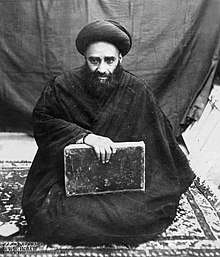Muhammad Hujjat Kuh-Kamari
Sayyed Muhammad Hojjat KouhKamre'i (Persian: سید محمد حجت کوه کمره ای, also transliterated Sayyid Muḥammad Ḥujjat Kūh-Kamarī; 1310–1372 AH[lower-alpha 1] / 1893–1953 CE)[1] was a Shia jurist and scholar in the principles of Islamic jurisprudence, hadith studies and narration studies. He was a Grand Ayatollah (marja') among Shia and founded the Hojjatiyyah (Ḥujjatiyyah) School in Qom.

Early life
Hujjat Kuh-Kamari was born c. 1310 AH[lower-alpha 1] / 1892–93 CE in Kuh Kamar, East Azerbaijan.[2] His silsila can be traced back to Ali ibn Husayn Zayn al-Abidin, the fourth Shia imam.[3]
Education
His father, Grand Ayatollah Sayyed Ali taught him Islamic jurisprudence and its principles.[4] In 1912, he moved to Najaf, where he would study for 19 years under teachers like al-Allama al-Yazdi, Diya' al-Din al-Araqi, Mirza Muhammad Husain Na'ini,[2] Sayyed Abul Hasan Isfahani, Abdul Karim Haeri, Shaykh Al-Shariah Isfahani, and Agha Ali Qouchani in jurisprudence, its principles and astronomy. He also learned mathematics and astronomy from Sardar Kaboli.[4] Notable students of Kuh-Kamari include Allameh Tabatabai,[1] Mirza Hashem Amoli, Mortaza Motahari, Jafar Sobhani, and Safi Golpaygani.[4]
Works
Kouh Kamarei wrote on various Islamic religious sciences like jurisprudence, its principles, hadiths and their transmission:
Social activity
Together with Sayyed Sadr Addin Sadr and Sayyed Muhammad Khansari, Kuh-Kumari was concerned with administration of the Qom madrasa under Reza Shah Pahlavi.[7] In Qom, Kuh-Kamari contributed to its hawza and founded the Hujjatiyyah School (Hojjatiyyah Madrasah),[1] which is nowadays part of the World Center of Islamic Sciences.[7]
Death
Kuh-Kumari died in 1372 AH[lower-alpha 1] / 1953 CE at the age of 62 and was buried in a small room near the Hojjatiyyah Madrasah in Qom.[1]
Notes and references
- Notes
- Lunar Hijri calendar
- References
- Sayyid Muhammad Husayn Husayni Tihrani (2011). "Prominent figures". Shining Sun. ICAS Press. p. 361. ISBN 978-1-904063-40-7.
- Stewart, Devin J. (2001). "The Portrayal of an Academic Rivalry – Najaf and Qum in the Writings and Speeches of Khomeini, 1964–78". In Linda S. Walbridge (ed.). The Most Learned of the Shi'a – The Institution of the Marja' Taqlid. New York: Oxford University Press, USA. p. 218. ISBN 978-0-19-534393-9.
- Modarres Tabrizi, 1374 solar & Reihanat Al Adab, p. 23
- Marashi, 1416 lunar & Mosalsalat fi Ijazat, p. 426
- Hoseini Eshkevari, 1377 solar & Hojjat Library catalogue, pp. 41–42
- Aqa Bozorg Tehrani, 1983 & Zariah, p. 25
- Sharif Razi & The works of Hojjah, pp. 185–190